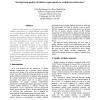Free Online Productivity Tools
i2Speak
i2Symbol
i2OCR
iTex2Img
iWeb2Print
iWeb2Shot
i2Type
iPdf2Split
iPdf2Merge
i2Bopomofo
i2Arabic
i2Style
i2Image
i2PDF
iLatex2Rtf
Sci2ools
ICSE
2003
IEEE-ACM
2003
IEEE-ACM
Moving from Quality Attribute Requirements to Architectural Decisions
Quality attribute models are proposed as the linkage between a specification of a quality attribute requirement and a design fragment that is focused on achieving that requirement. Each quality attribute model has a collection of parameters that must be specified in order to determine from the model whether a requirement will be met. These parameters can be bound through design decisions, through values given from a quality requirement, or through knowledge of the designer. Architectural tactics are designed to relate design decisions to control of a quality attribute model parameter in order to achieve particular responses. In this paper, we present a series of steps that enable moving from a single quality attribute requirement to a design fragment focused on achieving that requirement. We demonstrate these steps through application to an embedded system.
Related Content
| Added | 09 Dec 2009 |
| Updated | 09 Dec 2009 |
| Type | Conference |
| Year | 2003 |
| Where | ICSE |
| Authors | Felix Bachmann, Len Bass, Mark Klein |
Comments (0)

